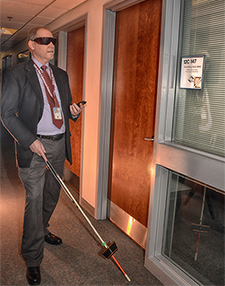
VA Research Currents archive
Technology horizons
Helping those with vision loss find their way
October 21, 2014

VA engineer David Ross models his RFID indoor wayfinding system.
(Photo by Adam Hernandez)
VA engineer David Ross models his RFID indoor wayfinding system.
(Photo by Adam Hernandez)
Thanks to technology, blind people and those with low vision are now able to find their way around independently with greater ease. VA has been a leader in the field historically, and today, several wayfinding projects are in the works at the Center for Visual and Neurocognitive Rehabilitation, based at the Atlanta VA Medical Center. Here's an overview:
- Researchers are developing a smartphone app that takes advantage of "sensor fusion" to track user movement. An outdoor version of the product fuses data from GPS with data from the magnetic compass, gyrocompass, and accelerometers found in most smartphones. This provides highly accurate location information that could help users easily find destinations such as a crosswalk or building entrance.
- The center is also investigating the use of radio-frequency identification (RFID), which uses electromagnetic fields to transfer data. It's the same technology that allows people to scan items at the store or drive through a tollbooth with an E-ZPass tag. One project is exploring RFID tags on Braille signs as a way to send information automatically to smartphones that can read the tags. This would be an alternative to Low Energy Bluetooth transmitters. VA engineer David Ross says, "The advantage of RFID tags is that they require no power, while the Bluetooth transmitters run on batteries that must be changed every couple of years."
- In another project, researchers are working with commercial partners on fast-darkening sunglasses for people with age-related macular degeneration or similar conditions. A special "electrochromic" film applied to the lenses helps them darken and lighten in just a few seconds, much quicker than traditional transition lenses. The glasses are equipped with light sensors that automatically trigger the changes.
One advantage, says Ross, is that the film "adjusts dynamically as the light changes while moving around outdoors. If a cloud comes over the sun, it adjusts automatically to the best level for the person for the level of light in that moment. Also, for those who still drive, it automatically adjusts as you drive, so as the sunlight changes, or you go into the shadow of buildings and back out into sunlight, it adjusts for you automatically." He notes that transition lenses rely on UV light from the sun to adjust. Since car windshields block this UV light, transition lenses do not dynamically adjust while users are driving.
- The center is collaborating with University of Maryland computer scientist Dr. Jon Froelich on a Department of Defense-funded project called HandSight. A tiny camera small enough to embed in a false fingernail is worn by the user and connected to a smart watch. The watch vibrates to signal that the user has placed his finger on a line of text, and then scanning the finger along the text activates software that translates the text into spoken output heard on a Bluetooth earpiece. When the user touches an article of clothing, software in the watch recognizes the colors and patterns and helps with coordinating an ensemble.
The researchers also plan to have HandSight serve as an interface to a smartphone. It will treat the surface of the user's hand as the touch screen.
Says Ross: "Users will be able to open and run apps simply by touching the palm of their hand.They will be able to set up specific parts of the hand as 'favorites' for commonly used functions, such as finding out the time or calling a friend. A user might touch his ring finger, for instance, to call his wife."

